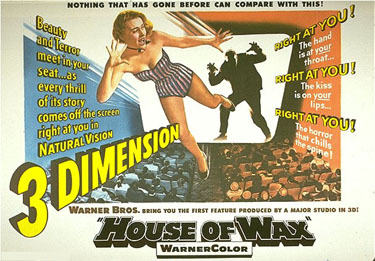With competition from television and other leisure activities following the Second World War, Hollywood introduced a number of technical innovations in an attempt to maintain audience numbers. One such innovation was 3-D film. 3-D film has a three-dimensional, stereoscopic form, creating the illusion of depth. This illusion is typically achieved by the wearing of special red-and-blue (or red-and-green) or polarized glasses. Among the major 3-D releases during the postwar period were House of Wax (1953), Kiss Me Kate (1953), and Alfred Hitchcock’s Dial M for Murder (1954). Today, 3-D is employed only rarely in Hollywood films, and is more often seen in IMAX films or in specialized theaters at amusement parks or museums.
